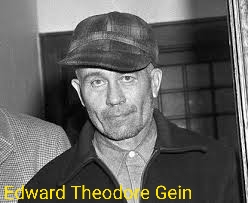Edward Theodore Gein

Edward Theodore Gein
Edward Theodore Gein,Known as the butcher and ghost of Plainfield.He was an American convicted murderer.
Early years
Born 8/27/06 to Augusta and George Gein. He was born in LaCrosse Wisconsin. He had one older brother Henry Gein. George was a violent alcoholic and went for many times unemployed. Augusta was a religious puritan who taught her boys against premarital sex and "Evil" women. In 1914 Augusta moved the family to an isolated farm in Plainfield Wisconsin, which is where Ed remained his entire life.
Family Members Deaths
George was the first of the Gein family to pass away. Complications from his alcoholism were his ultimate demise in 1940. Brother Henry would be the next to die in 1944 while fighting a fire on their farm. After a long day of fighting a farm fire Ed reported his brother missing. He was found later that evening face down. Conflicting reports have Henry's true form of death as either aspyxiation or as murder by Ed. Though the official cause of death was accidental asphyxiation, many believe Ed murdered Henry so he could be alone with his mother.
Very soon after Henry died, Augusta suffered two debilitating strokes. Ed cared lovingly for his mother after her first stroke. In 1945 Augusta died at age 67. Author Harold Schechter said Ed had "lost his only friend and one true love. And he was absolutely alone in the world." Very soon after Augusta's death Ed nailed her bedroom door shut.
Grave Robbing and Bizarre Behavior
Between the years 1947 and 1952 Ed and a simple minded neighbor Gus visited numerous graves and dug up women's body parts. Ed removed parts from each body and even dug up his mother. He used the items from the graves to create things like bowls made from skullcaps, hanging mobiles with body parts, and lampshades made from skin. More disturbingly he made a belt made from nipples, leggings from women's skin, a collection of vulvas, and a mammary vest. Ed became very confused in his sexuality and would dress in the women's skin and dance around in the moonlight. He was even reported to have attempted to castrate himself.
Official official and unofficial murders
12/8/54 was the date of the first official murder by Ed. He killed tavern owner Mary Hogan, but claimed he had no remembrance of the actual killing.
Parts of Mary were found in the farmhouse belonging to Ed. Then on 12/16/57 hardware store owner Bernice Worden became Ed's Police quickly suspected Ed, because Bernice's son reported that Ed would be soon purchasing anti-freeze. The morning that Bernice went missing, the last receipt that was written was for The morning that Bernice went missing, the last receipt that was written was for antifreeze. Police went to the Ed's farm, and found Bernice's body, headless and hanging upside down, and dressed out like a deer.
Ed was a suspect in the murder's of two young girls, aged 8 and 15. He was also suspected in the disappearance of two hunters. The hunters had left an bar located in Plainsfield, Ed's home town. Never to be seen again.
Arrest and Incarceration
Ed finally did admit to killing Bernice and Mary, but claimed he was in a "dazed state" and couldn't remember the killing themselves. He seemed to show little emotion during the interrogation sessions, even being cheerful at times. He plead not guilty by reason of insanity. His diagnosis by one psychiatrist was schizophrenic and a “sexual psychopath.” In 1957 he was admitted and held in the Central State Hospital psychiatric ward.
Last years
Ed remained in the Central State Hospital until 1978 when he was moved to Mendota Mental Institute in Madison Wisconsin. He became senile in his late years, and he had a long bout with cancer. He died of respiratory failure in the geriatric ward at Mendota at aged 78. He was buried beside of the love of his life, his mother.
Other interesting facts
His gravestone became chipped from souveneir seekers for years. Eventually the majority of it was stolen in the year 2000, and replaced by a simple wooden cross, left by an unknown person.
Gein in popular culture has influenced fictional serial killers such as Norman Bates, Leatherface, and Buffalo Bill.

 My First News Item
My First News Item My Nine News Item
My Nine News Item

